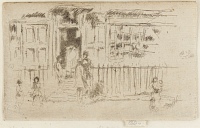Little Steps, Chelsea | ||
| Number: | 269 | |
| Date: | 1886 | |
| Medium: | etching | |
| Size: | 51 x 86 mm | |
| Signed: | butterfly at right | |
| Inscribed: | no | |
| Set/Publication: | no | |
| No. of States: | 2 | |
| Known impressions: | 5 | |
| Catalogues: | K.262; M.258; W.213 | |
| Impressions taken from this plate (5) | ||
KEYWORD
child, , people, shop-front, steps, street.
TITLE
There are several variations on the title, and several titles that may or may not refer to this etching, as follows:
'The Steps' (1886, Frederick Wedmore (1844-1921)). 2
'The Steps' (1887/1888, Whistler). 3
'The Steps Millmans Row' (1890/1891, Whistler). 4
Possibly 'Steps. The - Justice Walk' (1890/1892, Beatrice Whistler (1857-1896)). 5
'Lawrence St. Chelsea' (1903/1935, possibly Rosalind Birnie Philip (1873-1958)). 6
''The Steps, Chelsea' (1909, Howard Mansfield (1849-1938)). 7
'Little Steps, Chelsea' (1910, Edward Guthrie Kennedy (1849-1932)). 8
Kennedy wrote: 'This title ["Little Steps, Chelsea"] was given by Whistler in a list of plates cancelled'. However, no such list has been found. In the list of plates in Whistler's studio stock-taking there is one 'The Steps [tick] 3 1/4 x 2' which is presumed to be this etching. Thus the title, 'The Steps', which was also given by Wedmore, has been accepted.
The conflicting information on the sites - Millman's Row, Justice Walk or Lawrence Street - makes it impossible to add that information in the title.
'The Steps' (1886, Frederick Wedmore (1844-1921)). 2
'The Steps' (1887/1888, Whistler). 3
'The Steps Millmans Row' (1890/1891, Whistler). 4
Possibly 'Steps. The - Justice Walk' (1890/1892, Beatrice Whistler (1857-1896)). 5
'Lawrence St. Chelsea' (1903/1935, possibly Rosalind Birnie Philip (1873-1958)). 6
''The Steps, Chelsea' (1909, Howard Mansfield (1849-1938)). 7
'Little Steps, Chelsea' (1910, Edward Guthrie Kennedy (1849-1932)). 8
Kennedy wrote: 'This title ["Little Steps, Chelsea"] was given by Whistler in a list of plates cancelled'. However, no such list has been found. In the list of plates in Whistler's studio stock-taking there is one 'The Steps [tick] 3 1/4 x 2' which is presumed to be this etching. Thus the title, 'The Steps', which was also given by Wedmore, has been accepted.
The conflicting information on the sites - Millman's Row, Justice Walk or Lawrence Street - makes it impossible to add that information in the title.
DESCRIPTION
To left of centre a short flight of steps between iron railings leads to an open doorway into a dark passage, with a stair lit by a lantern at the end. On either side of the entrance are wooden panels or shutters, with a narrow window at the far left, and a wide shop window to right. A boy is standing on the steps, at left, and a man and a woman at the foot of the steps at right. On the pavement there are two children at the left, and a girl carrying a baby at the right.
SITE
Chelsea, London, UK. The envelope containing the copper plate is labelled 'Lawrence St. Chelsea', which is highly possible, for Lawrence Street was a short street off Cheyne Walk near Whistler's house in Chelsea, leading into Upper Cheyne Row. The houses shown in Whistler's etching are no longer there, but the current layout is similar: the houses are set back a little from the pavement, have steps up to the ground floor, and a semi-basement behind the railings.
In 1888 premises in Lawrence Street included the Cross Keys pub, two chandler's shops (Alfred Perkin at No. 11, and Charles Meakins opposite at No. 23) and two beer shops (Charles Gwinnell at No. 12 and William Bashford opposite at No. 17). One of the chandler's shops could have been the small shop seen in Whistler's etching, which is clearly a small scale business with miscellaneous goods in the window.
As for the alternative suggestions, Millman's Row does figure in more than one etching (i.e. Rag Shop, Milman's Row, Chelsea 329) and could well be the site of this etching. Finally, Justice Walk is less likely as a site; it links Old Church Street and Lawrence Street, but it was only being developed in the late 1880s (there was a Wesleyan Chapel but not much else).
Whatever the precise site, this etching represented, as Robins points out, a poor working class society, in an area with pockets of serious deprivation and poverty. 9 Apartments were small and overcrowded, and life was lived largely on the streets, as Whistler shows in this etching, with women standing in the doorways and children playing on the pavement and the gutter.
9: Robins 2007[more], pp. 131, 133.
